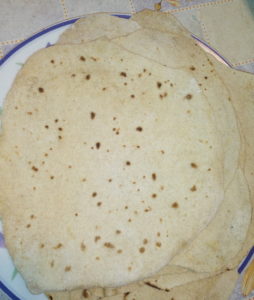When my friend Efrat asked on Facebook about the best tools for making bread, most people replied that they use their hands or a mixer. It seems that many people still see a food processor as a tool for slicing and chopping and the occasional cake. But if used correctly, the food processor excels at mixing and kneading all kinds of dough and batter.
For those of you who have never used it for anything but vegetables, I’ve compiled some tips to make the first time easier. The tips are applicable to all kinds of doughs and batters including challah, dinner rolls, pitas, tortillas, pasta, or pie crusts, and recipes made from non-wheat flours.
- If you are a beginner, start with a recipe using a small amount of flour like 2-3 cups (up to 500 grams or 1/2 lb).
- Use the plastic S-blade for any kind of dough or batter. You can learn here about how I ruined my previous machine after using the metal blade to make homemade pasta.
- For anything stickier than a cake batter, start with a food processor that has a strong motor. Usually that means 1000W or higher. Both a good-quality and a poor-quality machine will shut off if the motor gets too hot. But only a good one will start again.
- If the machine gets too hot and shuts off, make sure to turn off the power. Otherwise it could start again when you are not in the vicinity, and bounce its way off the counter.
- The tricky part of bread-making in the processor is getting the dough to turn into a ball. If you succeed, the dough comes out easily and the bowl stays relatively clean. Start by mixing the flour with the yeast, eggs, baking powder, or oil – everything but the water. While the machine is running, gradually pour in about 3/4 of the amount of water called for by the recipe. Then add the rest of the water even more slowly. Once the dough collects into a ball, you have added enough water. Let it run for another thirty seconds.
- Be careful! If you add too much water, you could end up with a sticky mess. Adding more flour at a that point doesn’t help, at least not for me. If that happens, it’s not terrible. Actually it is, or at least it’s time-consuming. Use a flat plastic spatula to remove as much dough as you can from the bowl and blade.
- Yeast doughs that need to rise can remain in the bowl, if there is enough room. Inserting the pusher into the feed tube will keep most of the air out.
- You can turn off the machine at any time during the mixing to check progress.
- If you don’t want the dough to rise in the food processor bowl, for example because there isn’t enough room, transfer the dough to a bowl or a cloth that has been dusted with flour. Some chefs recommend rubbing the dough with oil. Cover with a damp cloth, or wrap the entire bowl in a loosely tied garbage bag.
- After the dough doubles, shape it and let rise again.
- Use caution when making dough or batter in larger quantities. The manual should state the maximum amount of flour that the machine can handle. If not, experiment until you figure it out.
More posts on food processors:
Less is More: Review of Magimix 5200XL


I love using my food processor for breads. It’s great to just walk over and hit the pulse a few times every hour through the morning.